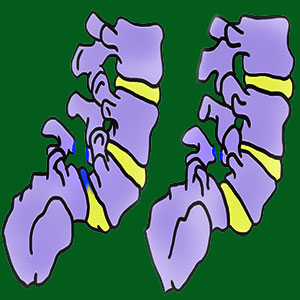
Fractured vertebra spondylolisthesis can occur due to congenital defects and/or traumatic injury. Some types of fractures can facilitate vertebral listhesis in either anterior or posterior directions. In other cases, listhesis might actually facilitate traumatic fracture of a vertebral bone, being a consequence of a listhesis process, rather than its underlying direct cause.
Spinal fracture can occur at many different areas of a vertebral bone and can affect congenitally or developmentally weakened bones, as well as strong, healthy bones that are exposed to excessive stress. Fracture can also occur in older patients and those with weak bones simply due to the weight of the body pressing down on the compromised vertebra. These compression fractures are often not even diagnosed unless they create pain or some pathological condition of neurological impingement.
This dissertation explores how vertebral fracture can play a role in the causation of listhesis given a variety of scenarios. We will also explore how the tendency towards listhesis can result in additional fracture to the affected vertebral bone. Finally, we will explore some solutions to vertebral fracture and resulting spondylolisthesis.
Fractured Vertebra Spondylolisthesis Causes
When a vertebra fracture occurs at the pars interarticularis, or in the region of the facet joints, it can set in motion a listhesis condition. This is especially true if the various spinal ligaments are undermined and not fully stabilizing the vertebral column in the fractured area.
Many people demonstrate congenital defects at the pars interarticularis that create openings in the vertebral bones or regions of focal thinning of the bone, leaving it susceptible to fracture. It is this causation that is responsible for virtually all cases of isthmus spondylolisthesis.
However, even fully and perfectly-formed vertebral bones can suffer traumatic fracture due to injury or recurrent stress. These fractures also leave the spine susceptible to listhesis and the very forces that enact the fracture can also be responsible for moving the vertebral forwards or rearwards into an acute anterolisthesis or retrolisthesis expression.
Degenerative spondylolisthesis is often the result of fracture in older patients and typically facilitated by decreased bone density/osteoporosis, obesity, sedentary lifestyle and general deterioration of the spinal structures. Compression fracture may or may not be symptomatic, but can have the potential to create widespread pathological consequences.
Spondylolisthesis Consequences
Some people do not demonstrate any defect that would facilitate a fracture and subsequent spondylolisthesis. However, they do demonstrate listhesis regardless and this usually very minor vertebral migration can actually increase the chances of them suffering a fracture and subsequently worsening spondylolisthesis in the future.
We see this condition regularly in people with hypermobile spinal joints. The slight listhesis often demonstrated, combined with the excessively wide range of motion of the individual spinal segments, can increase the chances of the person fracturing a vertebral joint upon trauma or simply due the effects of age and osteoarthritic activity.
Fractured Vertebra Spondylolisthesis Solutions
Most mild and moderate spondylolisthesis can be managed conservatively, as can most spinal fractures. Typically physical therapy and self-managed exercises and stretches will serve this purpose well. Some more significant listhesis profiles will require surgical stabilization, as do some types of serious and unstable fractures.
Spinal fusion can resolve both listhesis and fracture, but there are some other possible solutions for patient profiles where the listhesis is transitory and caused simply be an acute fracture. In these instances, kyphoplasty or vertebroplasty might provide far less invasive solutions that will correct the fracture and therefore, by default, also address the resulting spondylolisthesis. However, these procedures are available in limited supply and patients might have a difficult time finding a physician who can or will perform them, particularly given an emergency traumatic fracture scenario of causation.
Spondylolisthesis > Spondylolisthesis Causes > Fractured Vertebra Spondylolisthesis



